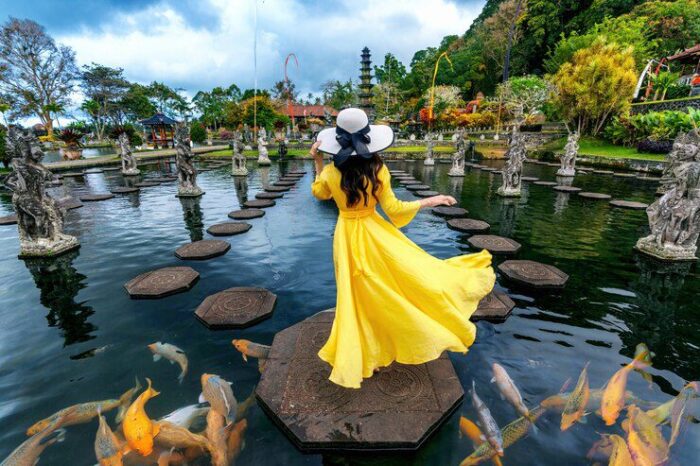Known as the Island of Gods, Bali is one of the most popular tourist destinations in Indonesia. This tropical paradise is renowned for its beautiful beaches, lush rice terraces, active volcanoes, rich culture, and warm hospitality. Beyond its idyllic seasides and Instagrammable pools, Bali offers a treasure trove of cultural and historical sites that provide a glimpse into the island’s fascinating past. In this article we talk about Must-Visit Cultural Sites In Bali In 2024.
From ancient Hindu temples to sacred monkey forests, regal palaces to renowned museums, Bali has no shortage of cultural attractions for visitors to explore. Read on for my recommendations of the top cultural sites that should be on every traveler’s Bali bucket list!
Table of Contents
Marvel at Tanah Lot – A Spellbinding Sea Temple
One of Bali’s most iconic landmarks, Tanah Lot is a Hindu sea temple perched dramatically atop a rocky outcrop amidst the crashing waves of the Indian Ocean. Dating back to the 16th century, Tanah Lot is among Bali’s most important sea temples – it is a popular pilgrimage site and said to be protected by the guardian spirits of the sea.
Catching sight of Tanah Lot’s distinctive silhouette, especially at sunset when its temples and shrines are silhouetted against the golden sky, is an awe-inspiring highlight for many visitors. The temple can only be accessed during low tide – local priests still use it for prayer and rituals. But you can admire Tanah Lot’s mystical beauty from various viewpoints on the cliffs above. Time your visit for sunset when the views are at their most atmospheric.
Discover Ubud’s Art Galleries and Museums
Known as Bali’s cultural heart, Ubud and its surrounding villages are brimming with art galleries, museums, traditional performances, and craft workshops, making it the ideal base for diving into the island’s living arts scene.
Blanco Renaissance Museum displays the life’s work of late Spanish artist Don Antonio Blanco, who lived in Ubud from the 1950s until his death in 1999. His vibrant, fantastical paintings perfectly capture Bali’s distinctive culture and mythology. At the nearby Neka Art Museum, you can trace the development of painting in Bali from pre-war styles to the influential Ubud art school.
For an insight into local village life, the magnificent Puri Lukisan Museum has an excellent permanent collection spanning all styles of Balinese art from the pre-war period to today. Don’t miss the elaborate carvings and architecture of ARMA (Agung Rai Museum of Art) itself, before exploring its impressive collection ranging from 19th-century classical Kamasan paintings to contemporary multimedia installations.
Be Transported to the Past at Taman Ayun Royal Temple
A magnificent example of traditional Balinese temple architecture, Taman Ayun was the main temple of the Mengwi Kingdom, which reigned in west Bali from the 17th to 19th century. The towering temple complex is surrounded by a wide moat and features imposing tiered pagodas with soaring thatched roofs, expansive courtyards, and ornate stone carvings.
Built in 1634 and renovated extensively by Chinese architects in 1937, Taman Ayun is dedicated to the Hindu gods as well as Balinese ancestral deities. Visitors can learn about the temple’s history in the onsite museum. Don’t miss admiring the towering shrine gates adorned with vibrant carvings of mythical beasts. Allow at least 2 hours to soak up the serene atmosphere and explore this impressive historical complex.
Wander through Sacred Monkey Forest Sanctuary
For an up-close experience with over 700 grey long-tailed macaques, head to the popular Sacred Monkey Forest Sanctuary in Ubud. This natural jungle is an important spiritual, economic, educational and conservation center for the village of Padangtegal. Hindu Balinese consider monkeys sacred – they guard the forest temples located here.
Along meandering pathways through the lush forest, you’ll have many delightful photo opportunities with these mischievous residents. Make sure to secure any loose items though, as the monkeys can be quite cheeky! It’s also worth reading up on etiquette for responsible monkey interactions.
Allow 1-2 hours to walk through the whole forest, visiting the three intricately carved temples interspersed among towering trees and mossy statues. Pura Dalem Agung Padangtegal is the main temple while the smaller temples are shrines to the village guardian spirits.
Immerse Yourself in Bali Aga Village Culture
For a glimpse into the unique culture and architecture of Bali Aga villages – the earliest inhabitants of Bali – visit Trunyan or Tenganan in Karangasem. Their way of life remains relatively unchanged from over 1000 years ago before the arrival of Hinduism to Bali.
Known as Bali Mula (“original Balinese”), the Bali Aga people adhere to a strict code of customs called awig-awig that guides their daily life, rituals, and unique traditions. Their customary village layout features distinctive communal bale meeting halls and intricately woven geringsing double ikat cloth.
In Trunyan, known as the ‘bau village’, see the ancient customs around death and funerals, while Tenganan is renowned for its frequent ritual battles. An authorized guide can explain the significance of their complex systems of laws, values, and rituals that form the foundation of modern Balinese Hinduism.
Be Moved by History at Ujung Water Palace
Built in 1919 by the last king of Karangasem, Ujung Water Palace dazzles from afar, floating serenely on shimmering ponds against a backdrop of Mount Agung. This picturesque ruin showcases both European and Balinese architectural styles, with its classical pillars, floral friezes, and temple-like spires reflected poetically on the water.
Once an opulent royal retreat, this palace was almost entirely destroyed when Mount Agung erupted in 1963. However, the rebuilt central pavilion and remnants of the old structures still transport you back to a bygone era of extravagance. Stroll along pathways through vibrant water gardens past fountains and stone gazebos.
Don’t miss the small onsite museum with historical photos, paintings, and memorabilia. Early mornings or late afternoons are the most peaceful times to visit before the crowds arrive. Ujung Water Palace is about an hour’s drive east of popular Candidasa Beach.
Marvel at Tirta Gangga Royal Water Gardens
No trip to East Bali is complete without visiting the lush former royal gardens of Tirta Gangga. Built in the 1940s for the Raja of Karangasem, this water palace features ponds, stone carvings, and fountains that channel water from nearby holy springs down to terraced pools amid gorgeous gardens.
Don’t miss admiring the iconic split gates framed by stone statues of Hindu gods and mythical creatures. Spend time wandering through the gardens discovering shrines tucked amid flowering frangipani trees and lily ponds. The higher levels provide gorgeous vistas over surrounding rice terraces to the ocean.
Allow 1-2 hours to see key highlights like the royal swimming pool, old changing rooms, and the water temple. Tirta Gangga makes an ideal peaceful stop midway through a driving route across East Bali.
Be Dazzled by Klungkung Palace and Kertagosa Pavilion
Once the royal seat of Bali’s most powerful kingdom, Klungkung Palace provides insights into the island’s political history and artistic heritage. While most structures were destroyed when the Dutch conquered Klungkung in 1908, the ceiling murals at Kertagosa Pavilion survived.
This open pavilion was used by royalty to hold court and dispense justice. Gaze up at the intricately painted ceiling depicting punishment in hell, reward in heaven, and other moral tales, brought to life in vivid comic-book panels. The artistic detail is incredible, featuring classic Wayang-style shadow puppets.
Adjacent to the pavilion, the remains of the palace temple and Kertha Gosa building hint at the former grandeur of this historic complex. Allow around 1 hour to see the key attractions and museum at Klungkung Palace.
Be Inspired by Penglipuran’s Living Traditions
Nestled on the slopes of Mount Batur, the charming village of Penglipuran offers a remarkably well-preserved glimpse into Bali’s culture. Often lauded as Bali’s cleanest and most beautiful village, traditional houses here are designed in the ancient Bali style.
Wander down its single main street lined with identical bamboo homes under soaring coconut palms. Admire the intricate stone carvings on their split gateways and see how villagers integrate nature, religion, and art in their daily life.
Make sure to visit the community hall or ‘bale banjar’ with its open verandahs – this is the heart of all village events and decisions. Penglipuran also hosts vibrant festivals, including the annual Kuningan harvest celebration when villagers make ceremonial offerings to thank the rice goddess.
Immerse Yourself in Penglipuran’s rich traditions by participating in a weaving or traditional dance workshop. Experience the warmth of Balinese hospitality as locals share stories of their village’s history and customs, offering insights into their sustainable way of life amid breathtaking natural surroundings. Whether exploring its timeless architecture, attending a local ceremony, or simply enjoying the serene ambiance, Penglipuran promises an authentic and unforgettable cultural immersion in the heart of Bali. I sincerely hope you find this “Must-Visit Cultural Sites In Bali In 2024” article helpful.

Jamal is the knowledgeable voice behind EDB Travel, bringing over 4 years of experience in travel writing and destination expertise. Holding a degree in Tourism Management, Jamal specializes in showcasing Jamaica’s rich culture, vibrant attractions, and hidden gems. His extensive background and local insights provide readers with valuable tips and in-depth guides to explore Jamaica like a pro. Follow Jamal on Pinterest and Instagram for the latest travel inspirations and updates.

